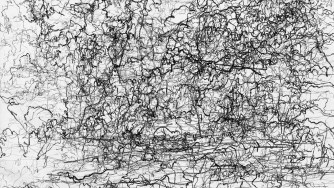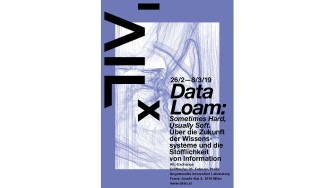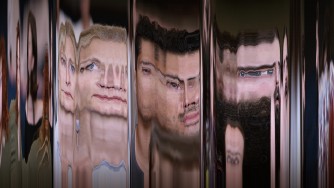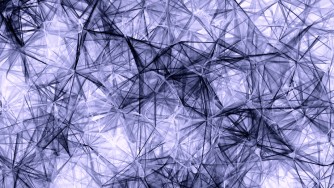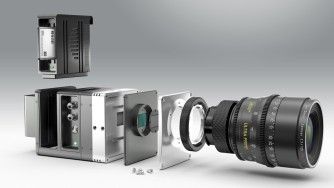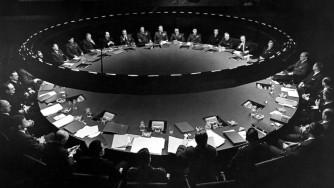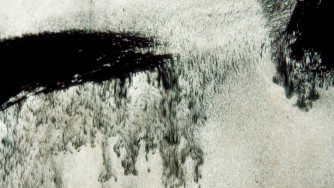Participation in research projects
In the course of teaching at the University of Applied Arts Vienna, participation in international research projects in various functions. Research, University
of Applied Arts, 2021
Radical Matter
The idea of "Radical Matter" owes its vitality to the wonderfully
strange behaviour that was predicted at the scale of atoms and subatomic particles. For a long time these so-called quantum
effects were pure theory, but nowadays they are more and more accessible and better understood – even to a degree that building
extremely powerful computers based on this technology seems only a few years away.
In the past, ground-breaking scientific discoveries often have shifted our understanding of the world. It is only logical that also the laws of quantum physics will affect the way we think and act as humans over time. In the case of quantum physics however this might be a quite radical change, since it contradicts the world as we know it fundamentally: there, linear time does not exist as such; in quantum mechanics, time can even go backwards. The very same object can appear at the same moment at several places millions of light years away. And as if this were not strange enough, every attempt to witness these events would change their outcome in an unpredictable way.
At the moment, the world of quantum physics however is only accessible via complex machines. In order to interact with this unknown universe, we need to invent new tools and languages in order to become an active part or even inhabitant of this part of reality. As a consequence our lives will have to interweave with that of machines in an unprecedented way that will exceed today's predictions by far. This closer and more subtle co-existence with complex machines will open up new worlds – not only in computing and in the sciences – but also in philosophy, art, literature, engineering, gaming.
The intent here is not to design a "new product" – instead, we intend to show how this new alliance between the sciences and the arts is critical in order to envision future possibilities. We want to explore practical ways to implement their impact on our planet and ourselves and think that this can only be done by foregrounding a non-hierarchical, arts practice led research.
The result of the "Radical Matter" project very likely will be something along the lines of a "roadmap" – a guide to the unknown that is written while we are on the journey. This however is an unconventional map, one that takes account of the fact that we are, as we are moving, changing the very events being mapped. Perhaps unsurprisingly, this kind of approach mirrors the very techniques required for art making and, indeed, for all forms of invention.
In the past, ground-breaking scientific discoveries often have shifted our understanding of the world. It is only logical that also the laws of quantum physics will affect the way we think and act as humans over time. In the case of quantum physics however this might be a quite radical change, since it contradicts the world as we know it fundamentally: there, linear time does not exist as such; in quantum mechanics, time can even go backwards. The very same object can appear at the same moment at several places millions of light years away. And as if this were not strange enough, every attempt to witness these events would change their outcome in an unpredictable way.
At the moment, the world of quantum physics however is only accessible via complex machines. In order to interact with this unknown universe, we need to invent new tools and languages in order to become an active part or even inhabitant of this part of reality. As a consequence our lives will have to interweave with that of machines in an unprecedented way that will exceed today's predictions by far. This closer and more subtle co-existence with complex machines will open up new worlds – not only in computing and in the sciences – but also in philosophy, art, literature, engineering, gaming.
The intent here is not to design a "new product" – instead, we intend to show how this new alliance between the sciences and the arts is critical in order to envision future possibilities. We want to explore practical ways to implement their impact on our planet and ourselves and think that this can only be done by foregrounding a non-hierarchical, arts practice led research.
The result of the "Radical Matter" project very likely will be something along the lines of a "roadmap" – a guide to the unknown that is written while we are on the journey. This however is an unconventional map, one that takes account of the fact that we are, as we are moving, changing the very events being mapped. Perhaps unsurprisingly, this kind of approach mirrors the very techniques required for art making and, indeed, for all forms of invention.
Exhibition, Research, University of Applied Arts, 2019
Data Loam - Sometimes Hard, Usually Soft
The artists and scientists
of the Data Loam project, are investigating the past and future of knowledge systems and postulating the urgent need to develop
new forms of organization beyond the established categorizations and indexations. The aim must be to liberate ourselves
from traditional lexical and encyclopedic orders and dissolve the hierarchies and valuations inscribed in them without creating
new (and perhaps more profound) distortions. Instead of continuing to work towards a reductive binary ontology, we want rather
to examine information as a dynamic network of interacting particles and thus ultimately as a form of matter in which the
ambivalent, the undecidable and the ephemeral can also be integrated and depicted.
Film, Research, 2018
tx-reverse
A space time cut through cinema.
Austria/Germany 2018, short film, DCP, color, 1:2,39 / "tx-reverse 360°": Austria/Germany 2019, installation in 360°, 10K
Length: 5 min.
Link to the trailer.
What is behind the cinema screen? It is not surprising that cinema-in-the-cinema scenes are often used in horror films. For they irritate and unsettle by reminding us – the immobile viewers hidden in the cosy darkness – of our own questionable position. What if the forces of unlimited imagination penetrate through the canvas into our reality? What if the auditorium dissolves and with it the familiar laws of cinema itself? In a way never before seen, "tx-reverse" shows this collision of reality and cinema and draws its viewers into a vortex in which the familiar order of space and time seems to be suspended.
Back in the 1990s, Martin Reinhart invented a film technique called "tx-transform", which exchanges the time (t) and space axis (x) in a film. Normally, each individual film frame represents the entire space, but only a brief moment of time (1/24 second). In the case of tx-transformed films, however, the opposite is true: each film frame shows the entire time, but only a tiny part of the space – in cuts along the horizontal spatial axis, the left part of the image thus becomes the "before", the right part the "after".
20 years after Martin Reinhart and Virgil Widrich used this film technique for the first time in a short film ("tx-transform", 1998), they again deal with the question of which previously unseen world arises when space and time are interchanged, aptly in a cinema and at full 360°: at the Babylon Kino in Berlin they filmed with the OmniCam-360 about 135 actors and calculated the installation "tx-reverse 360°" for the ZKM from this material.
Winner of 39 international film awards!
Austria/Germany 2018, short film, DCP, color, 1:2,39 / "tx-reverse 360°": Austria/Germany 2019, installation in 360°, 10K
Length: 5 min.
Link to the trailer.
What is behind the cinema screen? It is not surprising that cinema-in-the-cinema scenes are often used in horror films. For they irritate and unsettle by reminding us – the immobile viewers hidden in the cosy darkness – of our own questionable position. What if the forces of unlimited imagination penetrate through the canvas into our reality? What if the auditorium dissolves and with it the familiar laws of cinema itself? In a way never before seen, "tx-reverse" shows this collision of reality and cinema and draws its viewers into a vortex in which the familiar order of space and time seems to be suspended.
Back in the 1990s, Martin Reinhart invented a film technique called "tx-transform", which exchanges the time (t) and space axis (x) in a film. Normally, each individual film frame represents the entire space, but only a brief moment of time (1/24 second). In the case of tx-transformed films, however, the opposite is true: each film frame shows the entire time, but only a tiny part of the space – in cuts along the horizontal spatial axis, the left part of the image thus becomes the "before", the right part the "after".
20 years after Martin Reinhart and Virgil Widrich used this film technique for the first time in a short film ("tx-transform", 1998), they again deal with the question of which previously unseen world arises when space and time are interchanged, aptly in a cinema and at full 360°: at the Babylon Kino in Berlin they filmed with the OmniCam-360 about 135 actors and calculated the installation "tx-reverse 360°" for the ZKM from this material.
Winner of 39 international film awards!
Research, University
of Applied Arts, 2017
Data Loam
The current excess of computational capacity begun to bring central questions
about the nature of the humanities and natural science to light. Questions that critical artists have started to ask long
before: how does science determine social structures, how does it shape our reality? What was important enough to be a subject
to further examination, what has been overlooked or deliberately suppressed?
We want to go one step further and use novel computer-assisted research as well as software-based visualization methods to understand how knowledge is organized in world information systems like The Library of Congress or Wikipedia. We want to develop an interface to this "topography of knowledge" in order to see how these powerful systems express a structure to the information they contain over and above the facts themselves, since this is inherent to the ideologies used to catalogue and index them, all of which evolve over time.
The novel view we will pursue, addresses objects and objectivity but, unlike traditional metrics, the materiality of the objects will be considered in an expanded sense; that is, via the multiple vectors of meaning (perception, opinion, facticity, truth, semantics) that have been attributed to them over time whilst, simultaneously addressing the ‘radical matter’ of the algorithms as constituted by the flow of zeroes and ones. This "topography of knowledge" will enable a stronger relation to Big Data (or Metadata) as something quite different and far removed from surveillance or invasion of privacy; it will, at least in part, work toward the ability to establish a stronger, profoundly pluralistic democracy of objects and to understand human prejudice as a historical factor that can be calculated and traced.
We want to investigate and explore the possibilities of artistic interaction with these big "bodies" of data and are proposing to transform data into some kind of "matter" that allows us to touch, restructure and re-organize it.
DATA LOAM – the new material we want to introduce with this project – is based on the substance that already is used (and often abused) by institutions, governmental agencies and industries. We want nothing less than to enable everyone to create and shape a true/fictional/absurd variation of the world as we know it: A laboratory of possible realities. Data Loam will provide a powerful set of metrics that can be used to enable anyone to ‘think outside the box’ whilst simultaneously ushering in a replacement paradigm which encourages all of us to be the philosophers and artists of our time.
We want to go one step further and use novel computer-assisted research as well as software-based visualization methods to understand how knowledge is organized in world information systems like The Library of Congress or Wikipedia. We want to develop an interface to this "topography of knowledge" in order to see how these powerful systems express a structure to the information they contain over and above the facts themselves, since this is inherent to the ideologies used to catalogue and index them, all of which evolve over time.
The novel view we will pursue, addresses objects and objectivity but, unlike traditional metrics, the materiality of the objects will be considered in an expanded sense; that is, via the multiple vectors of meaning (perception, opinion, facticity, truth, semantics) that have been attributed to them over time whilst, simultaneously addressing the ‘radical matter’ of the algorithms as constituted by the flow of zeroes and ones. This "topography of knowledge" will enable a stronger relation to Big Data (or Metadata) as something quite different and far removed from surveillance or invasion of privacy; it will, at least in part, work toward the ability to establish a stronger, profoundly pluralistic democracy of objects and to understand human prejudice as a historical factor that can be calculated and traced.
We want to investigate and explore the possibilities of artistic interaction with these big "bodies" of data and are proposing to transform data into some kind of "matter" that allows us to touch, restructure and re-organize it.
DATA LOAM – the new material we want to introduce with this project – is based on the substance that already is used (and often abused) by institutions, governmental agencies and industries. We want nothing less than to enable everyone to create and shape a true/fictional/absurd variation of the world as we know it: A laboratory of possible realities. Data Loam will provide a powerful set of metrics that can be used to enable anyone to ‘think outside the box’ whilst simultaneously ushering in a replacement paradigm which encourages all of us to be the philosophers and artists of our time.
Research, University
of Applied Arts, 2015
The European Union (Horizon 2020) funded project AXIOM develops
the first open source film camera. The project is hosted at Art
& Science at the University of Applied Arts Vienna and involves
a consortium of four other organisations in three different EU countries: Apertus
Association (Austria), antmicro (Poland), af inventions (Germany) and Denz (Germany).
Research, University
of Applied Arts, 2014
The Future of the Control Room
The department Art & Science at the University
of Applied Arts Vienna hosts the research project "The Future of the Control Room". The aim of this research project
is to question the current state of control rooms and thereby create new concepts for an overall design of how a future control
room could look like. The Research includes the fields of history, film, architecture, human-computer interaction, software,
GUI-development and the politics of interface design.
Research, 2013
Night of a 1000 Hours
June
2nd to 9th, participation in the workshop "Light Days/Light Nights" by DOP Christian Berger in Ilovic,
Croatia.
Research, University
of Applied Arts, 2012
Liquid Things
Materials have always been transmitters of messages. Today they
have acquired a new relevance as a result of the increasing flows of information that shape our societies. Consequently, many
scientific fields are simultaneously developing ways of expanding the potential of matter to handle these flows. On the road
to realising concepts like "programmable matter" or "adaptive architecture", research groups on "mediated matter", "transitive
materials" and "metamaterials" have recently emerged. However, these young realms are characterised by a mechanistic way of
thinking which leaves promising aspects of these novel, active and metamorphic materials unelaborated.
Considering Gaston Bachelard’s poetic essays on the influence of matter on imagination and that fact that our culture has been charged with ideas about transformations since the apparition of Ovid’s "Metamorphoses" two thousand years ago, we propose a practical and critical approach to the genuine advances in this field made by computer and materials sciences, physics and chemistry to face questions regarding issues such as the physical resonance of materials becoming active or their potential to cause a renegotiation of our material reality.
We take both referential contexts, namely the scientific developments and the imagination applied to transformations of matter and combine them to present new ideas, concepts and concrete actions with the intention of expanding artistic perspectives.
The project Liquid Things is organised in three modules: Material/Technology, Theory/Reflection and Art/Process, each including several international invitations for concentrated, time-limited cooperations ending in individual presentations. The first module focuses on experiments with novel materials; the second deepens the context and sets the theoretical framework for our research; and finally, the third consists of the creation of artistic prototypes. The main outcomes are presented in: two workshops on the artistic manipulation of active materials, a symposium that reflects on the theoretical and practical field addressed in the project in relation to art-based research, an exhibition that places the prototypes in a public venue for open discussion and a final published book, which summarizes the processes, collaborations, activities and results of the project. The three modules are deeply intertwined and allow the development of a critical and simultaneously deep and original collaboration with matter.
Roman Kirschner
Considering Gaston Bachelard’s poetic essays on the influence of matter on imagination and that fact that our culture has been charged with ideas about transformations since the apparition of Ovid’s "Metamorphoses" two thousand years ago, we propose a practical and critical approach to the genuine advances in this field made by computer and materials sciences, physics and chemistry to face questions regarding issues such as the physical resonance of materials becoming active or their potential to cause a renegotiation of our material reality.
We take both referential contexts, namely the scientific developments and the imagination applied to transformations of matter and combine them to present new ideas, concepts and concrete actions with the intention of expanding artistic perspectives.
The project Liquid Things is organised in three modules: Material/Technology, Theory/Reflection and Art/Process, each including several international invitations for concentrated, time-limited cooperations ending in individual presentations. The first module focuses on experiments with novel materials; the second deepens the context and sets the theoretical framework for our research; and finally, the third consists of the creation of artistic prototypes. The main outcomes are presented in: two workshops on the artistic manipulation of active materials, a symposium that reflects on the theoretical and practical field addressed in the project in relation to art-based research, an exhibition that places the prototypes in a public venue for open discussion and a final published book, which summarizes the processes, collaborations, activities and results of the project. The three modules are deeply intertwined and allow the development of a critical and simultaneously deep and original collaboration with matter.
Roman Kirschner

